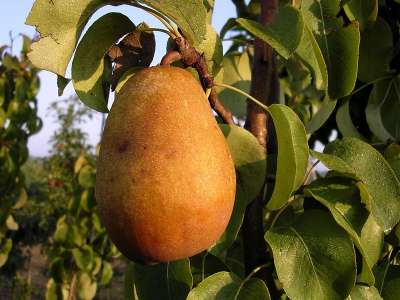Your basket is currently empty!
Tips & Recommendations for Growing Pear Trees
In general Pear trees prefer a more favoured aspect than Apples and may be less satisfactory in colder or more exposed area’s. They like a good deal of sun and a reasonably fertile soil. If this is a problem then why not consider growing delicious Pears as cordon or supercolumn trees by sunny wall or patio, they do very well grown in this way. Unusually perhaps, Pears fare better on clay soils than apples do.

If you need to plant new Pear trees click here.
Rootstocks for Pears
There isn’t quite such a variety of rootstocks as there is for Apples but there is still an adequate selection to suit all needs. Listed in order of size, smallest first.
Pyrodwarf
Pyrodwarf is the smallest tree of all but not compatible with all varieties. Relatively new on the scene, it provides a tree of 180-240cm’s in height and spread. Requires good soil conditions. Precocious and quick to reach fruiting-agel ideal for intensive orchard, very small gardens and container work.
Quince C
Quince C is the most commonly grown rootstock for Pears and makes an easily managed, productive tree that grows well over widely varying soils. The best stock for cordon, column, fan/espalier or bush growing. 200-260cm’s on average height and spread, less if grown in a large container.
Quince A
Quince A is more vigorous than Quince ‘C’ and the choice for orchard or grassland/paddock planting. Easy to grow and hardy. Tree sizes of 300-380cm’s height and spread are normal. Can be grown on a trunk with sufficient clearance to be mown beneath. Suitable for bush and half standard trees.
Pyrus communis & BA29
Pyrus communis and BA29 are both super-vigorous making large trees unsuitable for all except large areas; grass, orchard, paddock etc. They do tend to be hardy and more forgiving of soil and disease resistant but are difficult to harvest due to the fruit mostly being out of reach.

Varieties
Self fertile varieties of Pear
Remember ther majority of Pear varieties need to be planted in pairs or a group top provide good crops. If you sare only planting one tree then consider the following:
Conference, new compact Concorde, new very hardy Invincible, Durondeau, Improved Fertility and, to a lesser extent, Beurre Hardy, can all ne planted alone for good crops. The first 3 are the best varieties for this purpose.
Recommended Pear varieties
It’s so difficult to choose, we love them all! But forced to make choices, these make our shortlist based on the merits of superb flavour, ease and reliability.
Williams bon Chretien, Glou Morceau, Concorde, earlier ripening Beth, super-delicious newer cultivar Merton Pride, Dr Jules Guyot, Josephine de Malines,[pictured below] Invincible.

Good Pear varieties for colder and frosty area’s
Invincible, Cannock, Beurre Hardy, Concorde, Winter Nellis, and the cooking variety Catillac.

Bugs, diseases and problems in Pear trees
Scab
A very prevalent Pear tree disease. Symptoms are present on leaf and fruit; black-brown spots become bigger and bigger and can create whole patches that eat away at the leaf and discolour the fruits badly. Scab is more prevalent in wet area’s or during rainy seasons. Control by spraying can be sought by using sulphur or copper based fungicides. It has also been suggested that seaweed extract such as Maxicrop, applied as a foliar feed, has some effect. Encouraging healthy vigorous growth will help in avoiding scab and some varieties are more resistant than others.
Pear leaf blister mite
If yellow to orange pink blisters appear on the leaves in early Summer then it is leaf blister mite. These develop into blackish blothces that may cause defoliation of the tree by late Summer. Although it is not generally though of as a serious pest but it is unsightly and can become entrenched. Raking and burning falled leaves will help, a systemic insecticide may also have some effect, sprayed at intervals throughout the growing season.
Canker
A common disease of Apples & Pears is Canker which causes distinctive lesions on the trunk and branches themselves, these develop into sunken, flaking wounds. The disease is more troublesome in the wetter area’s of the country. The best course of action is to cut out infected wood, beyond the point of infection leaving only clean growth. If the canker is on the main trunk or a major limb then spraying with bordeaux mixture can help. Some varieties are more susceptable to canker than others.
Fireblight
Pears are particularly susceptable to Fireblight. Sudden die-back, with blackened shoots that appear as if burnt, are the signs. There is no cure except for the removal of affected wood to clean, live growth. The cutting tool must be disinfected between each cut to prevent re-infecting. Affected wood should be burnt. In severe cases it is probbaly best to remove the tree.






